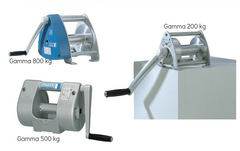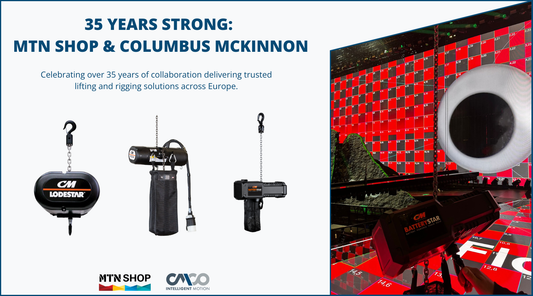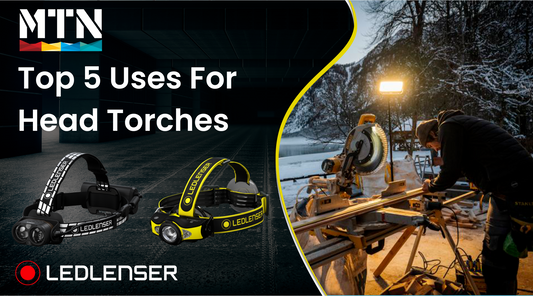Manual Winches vs. Electric Winches: What Wire Rope Winch is Right for You?
Article
Whether you’re in the market for a new winch or just replacing an old one, there are many factors to take into consideration before making a purchase. Today, we will cover the differences between manual winches and electric winches in order to help you decide which one is best for you.
What are Winches Used for?
A winch is a mechanical device to lift or move heavy objects. It winds wire around a drum (or a spool) while holding the wire rope steady until it needs to be adjusted. Winches are used for backstage mechanics in the film and live event industries. They are embedded in the floor to move large pieces on and off the set when needed. Winches are also used for industrial purposes like towing vehicles or boats or removing heavy rocks, trees, and cumbersome equipment.
What winch you need depends on your intended use; manual winches and electric winches each work best in different scenarios.
What are Manual Winches Best Used for?
With a capacity between 200kg and 5000kg, hand winches or called manual winches are operated by turning the ratcheting crank/lever to lift or pull a load.
If you wind the cable onto the cable spool, the winch will pull in a load. If you wind out, the device will let the load move away. Manual winches are easy to work with and require low maintenance effort. A hand winch is light and portable since it requires no electrical external power.
There's a myth that hand winches are for pulling and not recommended for lifting. As there are multiple types of winches available, they are fitted with different brakes that determine if the device is safe for lifting. For example, non-brake and ratchet hand-operated winches are designed for pulling instead of lifting. If they are used in vertical lifting applications and you lose control of the lever, the load and winch will be left in a precarious situation - the lever will violently spin to causes to load to freefall to the ground. If yours is a brake winch or gear worm winch, their specific brakes are designed with vertical lifting applications in mind.
Below are 3 examples of manual winches that work best in different environments.
1. PFAFF Wire Rope Winch (250 - 5000 kg)
With a rope drum of robust steel sheet, the wire rope winch is a manually operated wall winch with worm gear for lifting and lowering in different load classes. A load pressure brake ensures secure stability of the lifted load.
- Mounting
The winch housing is made of plated steel and is suitable for mounting, especially onto walls or masts by tightening all the screws. You will need M10, M12, M16, M20 or M24 screws depending on the model of the winch. The mounting structure has to sustain the maximum forces imposed by the winch and the mounting surface has to be flat.
- Rope coiling
1. Pass the end of the wire rope through the slot of the reel.
2. Fasten the wire rope by tightening the nuts of the built-in rope clamping device securely with a wrench.
3. Turn the winch by 180° when installed with a downward rope descent direction.
4. Calculate the rope length in such a way that at least 3 full turns of rope remain on the drum in the lowest load position.
- Loading & Operating
To secure a load, a load hook with a safety catch has to be secured to the wire rope with a solid eye and high-pressure rope clamp. It is not recommended to use the winch rope as a hitching device. To move the load, you can lift it by turning the crank in a clockwise direction or lower it by turning the crank in a counterclockwise direction.
2. PFAFF Aluminium Wire Rope Winch (200 - 800 kg)
Some hand winches are ideal for outdoor operations. With a rugged design, the Pfaff Aluminium Wire Rope Winch is a foot-mounted winch perfect for lifting and lowering loads outdoors. The spring-loaded brake built into the drum automatically holds the load.
- Mounting
The Aluminium hand winch is suitable for mounting on flat ground or base by tightening all the four screws at the base. You will need M8, M10, M12 screws depending on the model of the winch. The mounting structure has to sustain the maximum forces imposed by the winch.
- Rope coiling
1. Insert the rope in consideration of rope winding direction.
2. Tighten clamping screws.
3. Calculate the rope length in such a way that at least 3 full turns of rope remain on the drum in the lowest load position.
- Loading & Operating
The loading and operation directions are similar to the first manual winch but this hand winch allows you to change the crank sockets.
Before the beginning of work, depending on the individual operating modus you can insert the crank totally into the drum direct socket (fast speed) or into the drive pinion socket (load speed) until the safety device catches.
3. Checkmate Worm Gear Winch (250 kg)
The Checkmate Worm Gear Winch is used for raising and lowering a load or a person in conjunction with a suitable backup and rescue device.
By using a specific bracket, this worm gear winch can be attached to a TR3 tripod as a primary man-riding winch that is ideal for confined space activities if used with a rescue device.
What are Electric Winches Best Used for?
An electric winch is a motorized device used for lifting, pulling and positioning of loads. It is typically mounted to a vehicle’s front or rear bumper and is powered by direct current electricity provided by the vehicle’s electrical system. It works best in towing applications and is used primarily in the landscaping, power, and telecommunication industries.
Below are 3 examples of electric winches that work best in different environments.
- Yale Electric Winch
Electric winches are best used for lifting and pulling heavy loads. The Yale Electric Winch offers high performance in a compact cube design. It can lift 250-1000kg loads with its 0.55-1.1 kw motor. If you want a winch that makes it easier for the operator, then consider buying an electric winch.
- PFAFF Electric Winch
If you’re in the market for winches exclusively in the construction industry, the Pfaff Electric Winch is a perfect choice. This winch works best in an environment where quick and easy lifting and lowering of loads are needed. It has the capacity to lift loads up to 200kg and is designed for construction sites.
- PFAFF Electric Wire Rope Winch
Some electric winches work best in environments with temperatures ranging from -20o C to 40o C. More specifically, the Pfaff Electric Wire Rope Winch fits this category. This model offers six capacities ranging from 250kg to 2000kg. Plus, it has a powerful three-phase motor for multi-range voltage to help get the job done.
Do Weight Capacities Differ Between the Two Types?
Weight capacities don’t drastically differ between the two types of winches, other than by price point. Winches with higher weight capacities are more expensive than winches with lower weight capacities. For example, you can purchase the Pfaff Wire Rope Winch, a manual winch, for only €351 with 250kg capacity or the same winch for €2,388.60 with a massive 5000kg capacity. Fortunately, your choice of winch does not have to be limited to a specific type due to weight capacity.
What Wire Rope is Right for You?
The right wire rope for you is ultimately up to you to decide. Factors that determine which winch is right for you include preference, budget, weight capacity, and use of device. Manual and electric winches are both sound options, so there’s no going wrong!
Proper winch maintenance is key prolonging the life of your manual or electric winch. However, if you find yourself in need of a new one, you can shop manual and electric winches at shopmtn.eu.
FAQs by Professionals
What's the difference between a winch and a hoist?
The main factor differentiating a winch from a hoist is their braking system. Some winches are made with dynamic brakes that use the winch gears for resistance, resulting in instability for lifting or suspending loads. If you were to use a winch to suspend a load, the load could easily slip or the gears could become damaged, resulting in catastrophic failure.
Hoists, on the other hand, are designed using a mechanical braking system. This system features a physical brake that locks the suspended load, preventing the line from bleeding. Because hoists do not have a free spool mechanism, they are the best and safest option for lifting materials.
Can you use a winch as a hoist?
Generally speaking, no. It is not safe to use a standard winch to lift loads up off the ground, as it wasn't designed for this purpose and there is a risk that the load will be dropped. One of the key differences between winches and hoists lies in their braking systems.
Can you use a winch for lifting?
Yes or no. It depends on the type of brake of your winch. For example, non-brake and ratchet hand-operated winches are designed for pulling instead of lifting. The brakes in a brake winch and gear worm winch are designed with vertical lifting applications in mind.
What is a dynamic brake on a winch?
meaning the gear system will automatically hold the load. Dynamic brakes use the winch gears for resistance, which is why they are unstable for lifting or suspending loads









